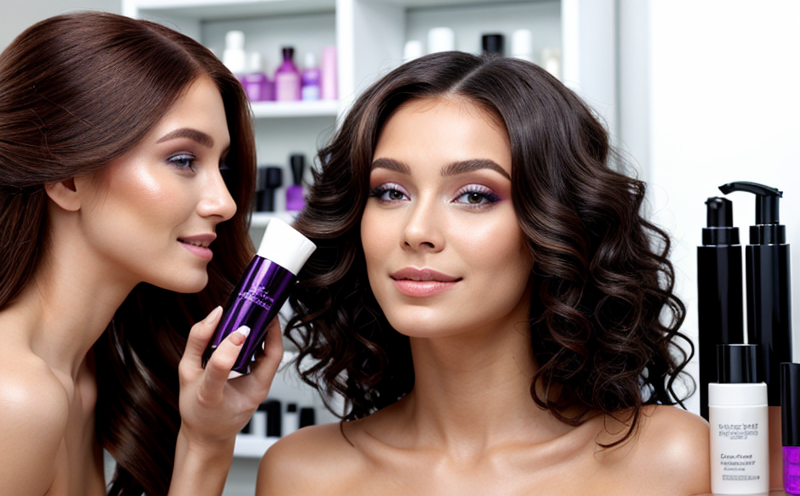Melanin Protection Testing in Hair Color Cosmetics
The melanin protection testing of hair color cosmetics is a critical process ensuring product safety and efficacy. This test evaluates the ability of hair dye formulations to protect natural pigments within the hair from degradation or loss during use. The primary goal is to maintain the integrity of the hair's natural color, preventing premature fading or unwanted changes in hue.
The melanin protection test involves several steps that are designed to simulate real-world conditions experienced by end users. Hair samples are prepared and exposed to various environmental factors such as light, humidity, and temperature fluctuations. These tests can be conducted under different protocols depending on the desired outcome—some focus on long-term stability while others prioritize immediate post-application effects.
Once the samples have been subjected to these conditions, they undergo analysis using advanced spectrophotometric techniques capable of measuring changes in melanin content accurately. The results provide insights into how effectively each product preserves its color over time or after exposure to specific stressors like UV radiation or high heat levels typically encountered during styling.
Understanding the role of melanin within hair structure is fundamental for developing effective hair care products. Natural pigments play a crucial part in protecting the scalp and enhancing overall appearance by absorbing harmful ultraviolet rays before they can reach deeper layers of skin cells beneath. When these protective mechanisms are compromised due to improper formulation practices or poor quality ingredients, consumers may experience undesirable outcomes like increased sensitivity or accelerated aging processes.
By rigorously testing melanin protection capabilities early in the development cycle, manufacturers can ensure their final products meet both performance standards set by regulatory bodies and consumer expectations regarding longevity and safety. This approach not only enhances brand reputation but also fosters trust among customers who value high-quality, reliable hair care solutions.
Benefits
The benefits of conducting melanin protection tests on hair color cosmetics extend beyond mere compliance with industry regulations. They offer valuable insights into the actual performance characteristics that matter most to consumers:
- Better Consumer Satisfaction: Products that effectively protect melanin contribute significantly towards customer satisfaction by delivering consistent results across multiple uses.
- Innovation Opportunities: Insights gained from these tests allow companies to innovate continuously, improving existing formulas or creating entirely new product lines tailored specifically for different consumer needs and preferences.
- Regulatory Compliance: Ensuring adherence to all relevant standards helps avoid costly recalls and reputational damage, which could otherwise arise if issues were not addressed proactively during the R&D stage.
In addition to these advantages, there are also broader societal impacts associated with responsible hair care practices. By minimizing environmental impact through reduced waste generation and promoting healthier lifestyles, companies contribute positively towards sustainable development goals.
International Acceptance and Recognition
Melanin protection testing is widely recognized internationally as an essential component of cosmetic product evaluation. Regulatory frameworks such as those established by the European Union (EU), United States Food and Drug Administration (FDA), and other global bodies emphasize the importance of protecting natural pigments during hair dye applications.
For instance, EU Cosmetics Regulation requires manufacturers to demonstrate compliance through extensive documentation proving successful completion of appropriate tests. Similarly, FDA guidelines outline specific procedures for evaluating colorfastness properties based on exposure scenarios relevant to end users.
The acceptance of such testing methods varies slightly between regions but generally aligns closely with the principles outlined in international standards like ISO 21967:2018 'Cosmetics - Determination of Color Fastness'. These documents provide detailed instructions for conducting experiments under controlled conditions, ensuring consistency and comparability across different markets.
By participating in these globally accepted practices, companies enhance their market reach by satisfying diverse regulatory requirements without sacrificing quality or innovation. This approach fosters trust among consumers worldwide who increasingly seek out brands that prioritize ethical manufacturing processes aligned with global best practices.
Use Cases and Application Examples
| Scenario | Description |
|---|---|
| New Product Launch | Testing new hair color formulations helps identify potential weaknesses in melanin protection early in the development cycle, allowing for timely adjustments to optimize product performance. |
| Product Reformulation | When reformulating an existing product line, it's crucial to assess any changes made regarding ingredients or processing methods that might impact melanin stability. |
| Compliance Audits | Regularly performing these tests demonstrates commitment to regulatory compliance and helps address any concerns raised during inspections or audits. |
| Research & Development | Investigating innovative ingredients or technologies aimed at enhancing melanin protection provides valuable data for future product advancements. |
| Customer Complaints Handling | Analyzing complaints related to color fading issues enables quick identification of problematic areas within the formulation, facilitating prompt resolution strategies. |
| Marketing Claims Verification | Evaluating whether marketing claims about melanin protection are substantiated through rigorous testing supports accurate communication with customers and maintains brand integrity. |
The above scenarios illustrate the diverse range of applications for melanin protection testing in hair color cosmetics. Each case highlights its significance in ensuring product quality, meeting regulatory requirements, fostering innovation, addressing customer concerns, verifying marketing claims, and maintaining brand reputation.





